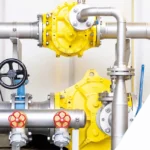
Advancements in Industrial Safety -Foam Dosing Systems
November 21, 2023
How to design the fire alarm system for logistic facilities
December 1, 2023
Advancements in Industrial Safety -Foam Dosing Systems
November 21, 2023
How to design the fire alarm system for logistic facilities
December 1, 2023Technical Library
Advancements in Tank Protection
Advancements in Tank Protection: A Technical Overview of Foam Suppression Systems
Introduction:
Industrial facilities often store flammable liquids or hazardous materials in large tanks, presenting a significant fire risk. To mitigate this risk, foam suppression systems are widely employed to provide rapid and effective fire suppression for tank protection. This article delves into the technical aspects of foam suppression systems, exploring their working principles, components, and applications in safeguarding against catastrophic fires.
Understanding the Need for Foam Suppression Systems:
1-Risk Assessment:
- Tanks containing flammable liquids or hazardous materials pose a substantial fire hazard, necessitating advanced fire protection measures.
2-Rapid Fire Suppression:
- Traditional fire suppression methods like water may not be sufficient for flammable liquid fires, making foam an ideal choice due to its ability to quickly smother and suppress flames.
Components of Foam Suppression Systems:
1-Foam Concentrate:
- Foam suppression systems utilize a specialized foam concentrate, a mixture of water, foam concentrate, and air.
- The type of foam concentrate is selected based on the specific application, considering factors such as the flammable liquid's properties and fire risk.
2-Proportioning System:
- The proportioning system precisely mixes the foam concentrate with water to achieve the desired foam solution concentration.
- Proportioning can be achieved through various methods, including bladder tanks, inline inductors, or foam proportioners.
3-Foam Generators:
- Foam generators, also known as foam makers or foam chambers, are devices that introduce air into the foam solution to generate foam.
- These generators are strategically positioned to cover the entire surface area of the flammable liquid in the tank.
Working Principles of Foam Suppression Systems:
1-Preventing Vapor Release:
- Foam suppresses fires by forming a blanket over the flammable liquid's surface, preventing the release of flammable vapors.
- This effectively cuts off the oxygen supply and suppresses the combustion process.
2-Cooling Effect:
- Foam has a cooling effect on the fire, reducing the temperature and preventing re-ignition.
- This is especially critical for suppressing fires involving flammable liquids with high heat release rates.
3-Sustained Protection:
- Foam suppression systems provide sustained protection, creating a long-lasting barrier that prevents reignition and protects adjacent tanks or equipment.
Applications and Considerations:
1-Tank Farms and Storage Facilities:
- Foam suppression systems are commonly used in tank farms, petrochemical facilities, and storage depots where large quantities of flammable liquids are stored.
2-Polar vs. Non-Polar Foam:
- The choice between polar and non-polar foam concentrates depends on the type of flammable liquid being stored, as each type is optimized for specific applications.
3-Foam Testing and Maintenance:
- Regular testing and maintenance of foam suppression systems are crucial to ensuring their reliability during an emergency.
- This includes periodic foam concentrate testing, equipment checks, and system inspections.
Conclusion:
Foam suppression systems are indispensable for protecting tanks containing flammable liquids, providing a swift and effective response to potential fire hazards. Understanding the intricate technical aspects, such as foam concentrate selection, proportioning systems, and foam generators, is essential for designing and maintaining robust foam suppression systems. As industries continue to prioritize safety, these advanced systems play a pivotal role in safeguarding both personnel and assets from the devastating consequences of tank fires.
